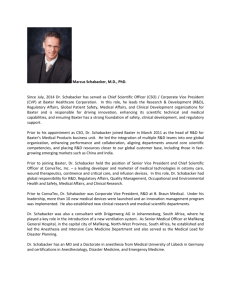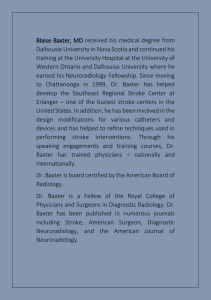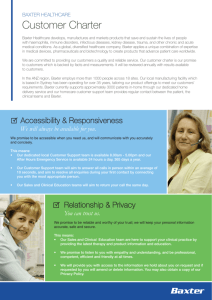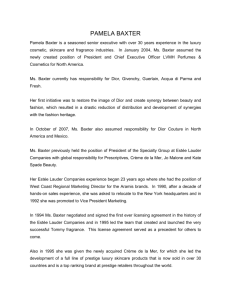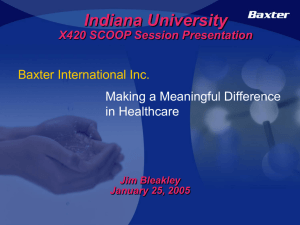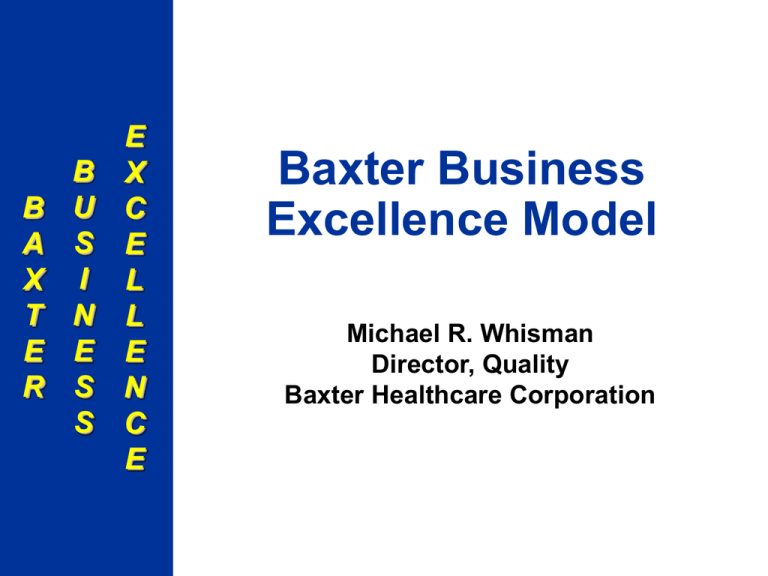
E
B X
B U C
A S E
X I L
T N L
E E E
R S N
S C
E
Baxter Business
Excellence Model
Michael R. Whisman
Director, Quality
Baxter Healthcare Corporation
Michael (Mike) R. Whisman
Ex-Army Captain (Viet Nam Era)
Over 33 Years – Healthcare
Industry (Manufacturing & QA)
20 Years at Baxter
Baldrige Examiner (1997 – 2009)
Shingo Examiner (2005 – 2009)
ASQ ITEA Judge (2002 – 2009)
2
Chairman, ASQ Team &
Workplace Excellence Forum
(2008 – 2009)
BS – Management (Texas A&M)
MBA – Pepperdine Univ.
6-Sigma Black Belt
Baxter Master Black Belt
40 Years - Married – 2 Grown
Kids, 1 New Grandson & Puppy
© Copyright 2006, Baxter International, All Rights Reserved
Questions
How many are implementing models?
What kind of issues do you face?
How many believe you have to have support from the top to
successfully implement?
Let’s take a look at the model we use at Baxter
3
© Copyright 2006, Baxter International, All Rights Reserved
MODEL - OVERVIEW
Baxter Business
Excellence Model
4
© Copyright 2006, Baxter International, All Rights Reserved
Baxter Business Excellence Model
Complete View
Strategic Challenges
Strategic Objectives
Value Streams & Key Metrics
A
S
S
E
S
S
Improvement Opportunity
Identification and Prioritization
Lean Six Sigma
DFSS / DMAIC Methodology
Tool Set
Total Employee Involvement
A
L
I
G
N
I
N
T
E
G
R
A
T
E
Tangible, Verifiable Results
5
© Copyright 2006, Baxter International, All Rights Reserved
Baxter Business Excellence Model
With Pictures
Strategic Challenges
Strategic Objectives
Value Streams & Key Metrics
Improvement Opportunity
Identification and Prioritization
Lean Six Sigma
DFSS / DMAIC Methodology
6s *
Kaizen **
Lean ***
Total Employee Involvement
Provides focus,
ensures alignment of
all employees towards
common goals, timetables and targets.
TOOLS
* Six Sigma – Variation
** Kaizen – Quick Change
*** Lean – Waste
Tangible, Verifiable Results
6
© Copyright 2006, Baxter International, All Rights Reserved
Strategic Challenges and Objectives
Strategic
Challenges
Internal Strategic Challenges
External Strategic Challenges
Operational
Customer
1.
2.
Organizational
3.
Business
4.
5.
Competitor/Market
6.
7.
8.
Supplier
9.
10.
Key Strategic
Challenges
Key Strategic
Objectives
Strategic
Objectives
1.
2.
3.
4.
5.
Note: Strategic Objectives can cover multiple Strategic Challenges
7
© Copyright 2006, Baxter International, All Rights Reserved
Baxter Business Excellence Model
Strategic Challenges
Strategic Objectives
Value Streams & Key Metrics
Improvement Opportunity
Identification and Prioritization
Lean Six Sigma
DFSS / DMAIC Methodology
6s
Kaizen
Lean
Map processes that
support key strategic
objectives and create
customer value.
Include baseline on
key measures and
targets for
improvement; lead
time, cost, quality,
yield, etc.
Total Employee Involvement
Tangible, Verifiable Results
8
© Copyright 2006, Baxter International, All Rights Reserved
Value Streams and Key
Internal Strategic Challenges
Strategic
Challenges
Operational
1.
Business
Organizational
2.
3.
4.
5.
Metrics
External Strategic Challenges
Customer
6.
Competitor/Market
7.
8.
Supplier
9.
10.
Key Strategic
Challenges
Key Strategic
Objectives
Key Metrics:
1, 2
1
1, 2
Targets:
A, B
A
A, B
9
© Copyright 2006, Baxter International, All Rights Reserved
Value Streams and Key Metrics
Move from departmental thinking…
Sales &
Marketing
Product
Development
Manufacturing
Information
Technology
Environment,
Health,
&Safety
Quality &
Regulatory
10
Supply
Chain
Finance
Human
Resources
© Copyright 2006, Baxter International, All Rights Reserved
Value Streams and Key Metrics
….To process thinking driven by key metrics with
customer and business excellence line-of-sight
EH&S
Quality &
Regulatory
Supplier
Sales &
Marketing
Customer
Value Creation
Product
Development
Product
Manufacturing
Human
Resources
Supply
Chain
Information
Technology
Finance
11
© Copyright 2006, Baxter International, All Rights Reserved
Example Value Stream Map
PRODUCTION
CONTROL
Supplier
Market
Changes
MRP
Market
Intelligence
Sales
Data
Weekly Schedule
Distributors
Weekly
Material
Shipment
Process Step #1
I
300 units
Process Step #2
Process Step #4
Process Step #3
I
I
I
50 units
50 units
150 units
C/T = 10 sec
C/O = 1 hr
C/T = 30 sec
C/O = 1 hr
Uptime = 85%
Yield = 70%
Uptime = 75%
Yield = 60%
C/T = 30 sec
C/O = 2 hr
Uptime = 95%
Yield = 80%
C/T = 20 sec
C/O = 2 hr
Uptime = 80%
Yield = 70%
Non-Value Add 50 min.
25 Min.
25 min.
50 min PCT = 151.5 mins
Value Add
10 sec.
30 sec
30 sec.
20 sec.
VAT = 1.5 mins
12
© Copyright 2006, Baxter International, All Rights Reserved
Opportunity Identification
Strategic Challenges
Strategic Objectives
Value Streams & Key Metrics
Improvement Opportunity
Identification and Prioritization
Lean Six Sigma
DFSS / DMAIC Methodology
6s
Kaizen
Lean
Total Employee Involvement
Tangible, Verifiable Results
13
© Copyright 2006, Baxter International, All Rights Reserved
Value Stream Map: Three Primary Purposes
Value Stream 1
Value Stream 2
Value Stream 3
1.
To engage the organization in
process thinking and
continuous improvement
2.
To identify improvement
opportunities through
process understanding
3.
To manage all improvement
efforts toward meeting all key
metric targets
14
© Copyright 2006, Baxter International, All Rights Reserved
Opportunity Identification, Prioritization and
Project Selection
Value Stream 1
0-6 months 12 months 24 months 36 months
future state future state future state ideal state
Quick Hit Quick Hit
Kaizen
Kaizen
Project 6-Sigma
6-Sigma Kaizen
6-Sigma Project
Kaizen 6-Sigma
Project Project
Project 6-Sigma
Measure Improvements Against Key
Metrics and Strategic Objective
15
© Copyright 2006, Baxter International, All Rights Reserved
Baxter Business Excellence Model
Strategic Challenges
Strategic Objectives
Value Streams & Key Metrics
Improvement Opportunity
Identification and Prioritization
Lean Six Sigma
DFSS / DMAIC Methodology
6s
Kaizen
Lean
Total Employee Involvement
Mechanism to drive
improvement.
Standardized
methodology and
language:
Define, Measure,
Analyze, Improve,
Control.
Lean Six Sigma
Toolkit.
Tangible, Verifiable Results
16
© Copyright 2006, Baxter International, All Rights Reserved
Value Analysis
Value Added Activities
Activities essential to deliver product or service
according to customer requirements. Three criteria:
Transforms the item or service toward completion
Customer cares (would be willing to pay for it)
Done right the first time
Non-Value Added Activities
All other activities. These activities are considered
waste.
17
© Copyright 2006, Baxter International, All Rights Reserved
Baxter’s 11 Wastes
Definition of Waste
• Overproduction
Waste is anything other than the minimum
• Waiting
amount of equipment, materials, parts,
space, and worker’s time which are
• Transportation
absolutely essential to add value to the
• Excess Motion
product.
Shoichiro Toyoda - President, Toyota
• Injuries
• Inadequate procedures/methods (processing waste)
• Unplanned Activities (processing waste)
• Inventory
• Poor Communication
• Defects (not meeting customer requirements)
• Variation
18
© Copyright 2006, Baxter International, All Rights Reserved
Lean Six Sigma
Strategic Challenges
Strategic Objectives
Value Streams & Key Metrics
Improvement Opportunity
Identification and Prioritization
Lean Six Sigma
DFSS / DMAIC Methodology
6s
Kaizen
Lean
Total Employee Involvement
Tangible, Verifiable Results
19
© Copyright 2006, Baxter International, All Rights Reserved
Tools
20
© Copyright 2006, Baxter International, All Rights Reserved
What is Lean Six Sigma (LSS)?
Lean
Six Sigma
A focus on waste
elimination, standardization,
cycle time reduction,
smooth process flow etc.
A focus on variation
reduction that impedes
optimized performance.
Lean Six Sigma is a robust, data-driven approach to
improve and manage key business processes.
21
© Copyright 2006, Baxter International, All Rights Reserved
The Methodology: DMAIC
IMPROVEMENT
CYCLE
DEFINE
MANAGE
... define the problem, clearly
and related to customer...
MEASURE
...measure what you care about;
know your measure is good...
ANALYZE
… look for root causes;
generate a prioritized list
IMPROVE
... determine and confirm
the optimal solution ...
…be sure the problem
doesn’t come back...
CONTROL
22
© Copyright 2006, Baxter International, All Rights Reserved
The Tools: LSS Toolkit
DEFINE
Is/Is Not
Diagram
MEASURE
ANALYZE
IMPROVE
Boxplot
Brainstorm
DOE
Dotplot
Fishbone
SIPOC
Charts
FMEA
MistakeProofing
Process
Flow Chart
Pareto Chart
Affinity
Value
Stream Map
CTQ
Multi-Voting
Project Y
Scatter
Kaizen
MSA
Pareto Chart
Visual Mgt.
6S
Gage R&R
Fault Tree
TPM
NPV
Surveys
Drilldown
5 Whys
VOC/CTQ
Kano Model
Process
Capability
Study
CONTROL
Control Plan
Standard
Work
Flexible
Workforce
Operating
Procedures
Revised
Process F
low
Project
Decommissioning
Level
6-Sigma Tests Loading
Takt Time
Pull/Kanban
23
© Copyright 2006, Baxter International, All Rights Reserved
Baxter Business Excellence Model
Strategic Challenges
Strategic Objectives
Value Streams & Key Metrics
Allocation of the
appropriate resources
and engagement of
the entire
organization.
Improvement Opportunity
Identification and Prioritization
Lean Six Sigma
DFSS / DMAIC Methodology
6s
Kaizen
Lean
Total Employee Involvement
Achievement of
results directly
supporting the
organization’s
strategic objectives.
Tangible, Verifiable Results
24
© Copyright 2006, Baxter International, All Rights Reserved
Business Excellence Model
Align - Integrate - Assess
Strategic Challenges
A
L
I
G
N
Assess progress
Strategic
towardObjectives
goals.
Value Streams & Key Metrics
A
S
S
E
S
S
Opportunity Identification,
Refineand
based
uponSelection
Prioritization,
Project
results and changes
to strategic
Lean
Six Sigma
challenges and
DFSS / DMAIC Methodology
strategic objectives.
6s
Kaizen
Lean
Total Employee Involvement
I
N
T
E
G
R
A
T
E
Tangible, Verifiable Results
25
© Copyright 2006, Baxter International, All Rights Reserved
MODEL - DEPLOYMENT
Baxter Efforts
25+ Years
26
© Copyright 2006, Baxter International, All Rights Reserved
Questions
How many have tried to implement a business model in
your company and were successful right out of the gate?
How many have tried to implement a business model and
slammed full on into cultural issues:
We’re different
Tried it before and failed
That stuff won’t work here
How many have actually made some inroads with
employees, only to see stubborn leaders kill the motivation?
27
© Copyright 2006, Baxter International, All Rights Reserved
Deployment Resources & Brief History
Initiated QLP in mid-80’s – World-wide Deployment
QLP Sr. VP reporting to CEO – Millions in Funding
64 Full time Director/Coaches to deploy program
All Leaders sent to Crosby School in Florida
Issues
Deployment to manufacturing world-wide. Division Leaders
made an effort.
Merger of Baxter and American Hospital
Did not include Technical Areas (i.e. R&D, IT, Finance, etc.)
28
© Copyright 2006, Baxter International, All Rights Reserved
Model History
Initiated QLP (Total Quality) in mid-80’s – World-wide
Deployment
QLP Sr. VP reporting to CEO – Millions in Funding
64 Full time Director/Coaches to deploy program
All Leaders sent to Crosby School in Florida
Initiated Baldrige Approach (1989) – Global intent
Deployment to manufacturing world-wide. Some Division
Leaders were successful.
Four Full-time VP’s, an award office of staff & 200+ Examiners
Leaders asked “QLP or Baldrige, which one?
29
© Copyright 2006, Baxter International, All Rights Reserved
Model History
Some Key Plants Initiated Shingo (2000)
Success - Manufacturing Plant Level
Not much interest elsewhere
Merged Shingo with Baldrige Approach (2005 – Present)
Builds on everything we learned thus far
Leaders at Many Levels of the Organization Interested
Lost enough, we are starting over in many areas
Manufacturing Plants – still generally the best examples
Great efforts being made in Quality Organizations
30
© Copyright 2006, Baxter International, All Rights Reserved
Model History
Lean (2002)
Success in Some Manufacturing Plants
One Key Leader
Business Excellence (2002)
One Sr. VP reporting to Corp. Quality VP
Eleven Person Corporate Group – Five Guru’s with five
coaches in training.
Strongest Support in Manufacturing & Quality
IT, Finance, Supply Chain, & a Division are Developing
31
© Copyright 2006, Baxter International, All Rights Reserved
Pitfalls We Experienced
QLP - Not Training Everyone at Once
Baldrige Model – Placing it in competition with QLP
Seeing LEAN, Six Sigma, Kaizen, etc. as Models
Succession Planning – Failure to consider culture/style
Reduction in Organizational Resources
Decentralization
Program not reporting to the top
32
© Copyright 2006, Baxter International, All Rights Reserved
What We Did Right
Stuck With IT – Saved Millions, Developed & Maintained
a Core Competence in Manufacturing
Merged it all Together
QLP – Culture
Baldrige/Shingo Model – Fits Partial & Complete Organizations
6-Sigma/Lean/Kaizen/Etc. as Tools
Implementation Anywhere There is Interest
Using Examples of Success to Tempt Leaders
Practicing What We Preach
Baxter is Charging for Success
33
© Copyright 2006, Baxter International, All Rights Reserved
34
© Copyright 2006, Baxter International, All Rights Reserved

